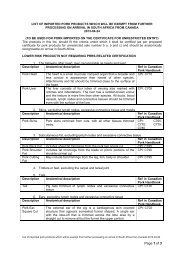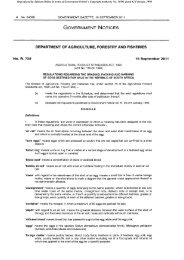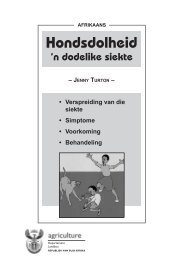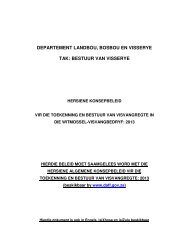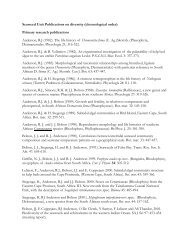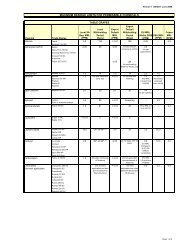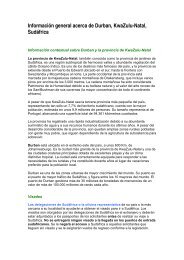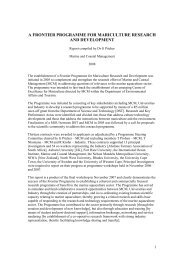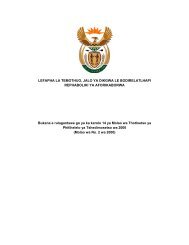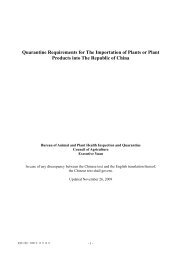Create successful ePaper yourself
Turn your PDF publications into a flip-book with our unique Google optimized e-Paper software.
S<br />
tube foot<br />
spine<br />
ea urchins are members of the phylum<br />
Echinodermata, which includes starfish, brittle<br />
stars, feather stars and sea cucumbers. Unlike the<br />
sea stars, sea urchins are usually spherical or<br />
pumpkin-shaped and the shell plates are fused into<br />
a hard shell (a test) that covers the whole body and<br />
lies just under the skin. A few, such as the pansy<br />
shell, are very flattened and have become bilateral as<br />
an adaptation to burrowing in sand. Live urchins<br />
are covered with spines that move on ball and<br />
socket joints and are their primary defence. Tiny<br />
stalked nippers (pedicellaria), located between the<br />
spines, keep the skin clean and snap at predators.<br />
The common Cape urchin uses these to paralyse<br />
the tube feet of starfish that attack it. Between the<br />
spines there are five double rows of long slender tube<br />
feet that end in suckers and work together with the<br />
moveable spines to propel the animal along. One<br />
larger plate in the shell forms a sieve through<br />
which water flows into a series of tubes (the water<br />
vascular system). This system is equivalent to a<br />
blood system and connects with gills and the tube<br />
feet, which can be extended by water pressure.<br />
C O A S TA L A N D M A R I N E L I F E – A N I M A L S : I N V E RT E B R A T E S – E C H I N O D E R M S<br />
Sea Urchins 3B<br />
Shell shows<br />
five-rayed symmetry<br />
Live Cape urchin<br />
Feeding<br />
The mouth of a sea urchin is on the lower surface of the body<br />
and the anus is usually on the upper surface. Nearly all urc h i n s<br />
are grazers. They use five large jaws, supported by powerful<br />
muscles, to scrape rock surfaces removing algae.<br />
Reproduction and life cycle<br />
Urchins have separate males and females. Eggs and sperm<br />
a re released into the water from five holes on the upper surface<br />
of the urchins. Once fertilised the eggs hatch into larvae, which<br />
develop through several stages that live in the plankton. The<br />
larvae are not ball-shaped but bilaterally symmetrical, with<br />
4-12 delicate long arms with bands of fine hairs. These arms<br />
are used for gathering food, swimming and floating.<br />
Distribution<br />
Many exotic and unusual species of sea urchin are found in<br />
the warm subtropical waters off KwaZulu-Natal but the Cape<br />
urchin and the heart urchins are the only common species<br />
that extend into the temperate conditions off the west coast<br />
of South Africa.<br />
Examples of sea urchins<br />
Cape Urchin Parechinus angulosus<br />
The Cape urchin is abundant on rocky shores around the<br />
whole coast. It is round and densely covered in shortish<br />
sharp spines. Its colour is very variable and can be purple,<br />
red, green or pink. The Cape urchin is an important herbivore,<br />
feeding on live seaweed, newly settled spores or drift weed. It<br />
often holds pieces of shell and seaweed with its tube feet as<br />
a shield from the sun, or for camouflage. Cape urchins play a<br />
special role by providing shelter for the vulnerable juveniles of<br />
‘perlemoen’ (abalone) so that they can escape predation from<br />
fish and rock lobsters. The green shells of dead Cape urchins<br />
are often picked up on the beach and are commonly known<br />
as sea pumpkins. The shell is like a jigsaw puzzle, made of<br />
plates fitted together. Rows of small holes indicate where the<br />
tube feet extend. There are also rows of knobs on which the<br />
spines articulate. The anus is in the upper centre, surrounded<br />
by five plates with distinct holes that are the reproductive<br />
pores from which eggs and sperm are shed.<br />
Needle Urchin Diadema setosum<br />
Black needle urchins, which occur in KwaZulu-Natal, have<br />
extremely long hollow spines. They are dangerous as their<br />
spines contain toxins and are needle sharp.





